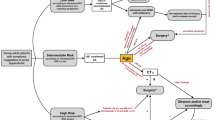Abstract
Background
Secondary signs of appendicitis on ultrasound may aid with diagnosis in the setting of a non-visualized appendix (NVA). This role has not been shown in the community hospital setting.
Materials and methods
All right lower quadrant ultrasounds performed in children for clinical suspicion of appendicitis over a 5-year period in a single community hospital were evaluated. Secondary signs of inflammation including free fluid, ileus, fat stranding, abscess, and lymphadenopathy were documented. Patients were followed for 1 year for the primary outcome of appendicitis. These data were analyzed to determine the utility of secondary signs in the diagnosis of acute appendicitis when an NVA is reported.
Results
Six hundred and seventeen ultrasounds were reviewed; 470 of these had an NVA. Of NVAs, 47 (10%) of patients were diagnosed with appendicitis. Sensitivity and specificity of having at least one secondary were 38.3% and 80%, respectively. The positive and negative predictive values of having at least one secondary sign were 17.3% and 92%, respectively.
Conclusion
These data suggest that the absence of secondary signs has a strong negative predictive value for appendicitis in the community hospital setting; however, the full utility of secondary signs may be limited in this setting.

Similar content being viewed by others
References
Doria AS, Moineddin R, Kellenberger CJ et al (2006) US or CT for diagnosis of appendicitis in children and adults? A meta-analysis. Radiology 241(1):83–94
Scholer SJ, Pituch K, Orr DP, Dittus RS (1996) Clinical outcomes of children with acute abdominal pain. Pediatrics 98(4 Pt 1):680–685
Mostbeck G, Adam EJ, Nielsen MB et al (2016) How to diagnose acute appendicitis: ultrasound first. Insights Imaging 7(2):255–263
Al-Khayal KA, Al-Omran MA (2007) Computed tomography and ultrasonography in the diagnosis of equivocal acute appendicitis. A meta-analysis. Saudi Med J 28(2):173–180
Puylaert JB (1986) Acute appendicitis: US evaluation using graded compression. Radiology 158(2):355–360
Estey A, Poonai N, Lim R (2013) Appendix not seen: the predictive value of secondary inflammatory sonographic signs. Pediatr Emerg Care 29(4):435–439
Jaremko JL, Crockett A, Rucker D, Magnus KG (2011) Incidence and significance of inconclusive results in ultrasound for appendicitis in children and teenagers. Can Assoc Radiol J 62(3):197–202
Kearl YL, Claudius I, Behar S et al (2016) Accuracy of magnetic resonance imaging and ultrasound for appendicitis in diagnostic and non-diagnostic studies. Acad Emerg Med 23(2):179–185
Keller C, Wang NE, Imler DL, Vasanawala SS, Bruzoni M, Quinn JV (2017) Predictors of nondiagnostic ultrasound for appendicitis. J Emerg Med 52(3):318–323
Nah SA, Ong SS, Lim WX, Amuddhu SK, Tang PH, Low Y (2017) Clinical relevance of the nonvisualized appendix on ultrasonography of the abdomen in children. BioMed Res Int 182:164–169.e161
Ross MJ, Liu H, Netherton SJ et al (2014) Outcomes of children with suspected appendicitis and incompletely visualized appendix on ultrasound. Acad Emerg Med 21(5):538–542
Crady SK, Jones JS, Wyn T, Luttenton CR (1993) Clinical validity of ultrasound in children with suspected appendicitis. Ann Emerg Med 22(7):1125–1129
Wiersma FTB, Bloem JL, Allema JH, Holscher HC (2009) US examination of the appendix in children with suspected appendicitis: the additional value of secondary signs. Eur Radiol 19(2):455–461
Cohen B, Bowling J, Midulla P et al (2015) The non-diagnostic ultrasound in appendicitis: is a non-visualized appendix the same as a negative study? J Pediatr Surg 50(6):923–927
Shah BR, Stewart J, Jeffrey RB, Olcott EW (2014) Value of short-interval computed tomography when sonography fails to visualize the appendix and shows otherwise normal findings. J Ultrasound Med 33(9):1589–1595
Srinivasan A, Servaes S, Pena A, Darge K (2015) Utility of CT after sonography for suspected appendicitis in children: integration of a clinical scoring system with a staged imaging protocol. Emerg Radiol 22(1):31–42
Alter SM, Walsh B, Lenehan PJ, Shih RD (2017) Ultrasound for diagnosis of appendicitis in a community hospital emergency department has a high rate of non-diagnostic studies. J Emerg Med 52(6):833–838
Larson DB, Trout AT, Fierke SR, Towbin AJ (2015) Improvement in diagnostic accuracy of ultrasound of the pediatric appendix through the use of equivocal interpretive categories. AJR Am J Roentgenol 204(4):849–856
Anandalwar SP, Callahan MJ, Bachur RG et al (2015) Use of white blood cell count and polymorphonuclear leukocyte differential to improve the predictive value of ultrasound for suspected appendicitis in children. J Am Coll Surg 220(6):1010–1017
Pastore V, Cocomazzi R, Basile A, Pastore M, Bartoli F (2014) Limits and advantages of abdominal ultrasonography in children with acute appendicitis syndrome. Afr J Paediatr Surg 11(4):293–296
Fallon SC, Orth RC, Guillerman RP et al (2015) Development and validation of an ultrasound scoring system for children with suspected acute appendicitis. Pediatr Radiol 45(13):1945–1952
Author information
Authors and Affiliations
Contributions
Study design was completed by JH and RR. The data collection and manuscript preparation were performed by JH, JA, and CM. Data analysis was performed by CM. Critical revisions were performed by all the authors.
Corresponding author
Ethics declarations
Conflict of interest
The authors have no financial conflicts of interest to disclose.
Disclosure
The views expressed are those of the authors and do not necessarily reflect the official policy of the Department of the Navy, Department of Defense, or the United States Government. In addition, the authors are military service members. This work was prepared as part of official duties. Title 17, USC, Section 105 provides that Copyright protection under this title is not available for any work of the US Government. Title 17, USC, Section 101 defines a US Government work as a work prepared by a military service member or employee of the US Government as part of that person’s official duties. Research data derived from an approved Naval Medical Center, Portsmouth, Virginia IRB, protocol; number NMCP.2015.0037.
Rights and permissions
About this article
Cite this article
Held, J.M., McEvoy, C.S., Auten, J.D. et al. The non-visualized appendix and secondary signs on ultrasound for pediatric appendicitis in the community hospital setting. Pediatr Surg Int 34, 1287–1292 (2018). https://doi.org/10.1007/s00383-018-4350-1
Accepted:
Published:
Issue Date:
DOI: https://doi.org/10.1007/s00383-018-4350-1




